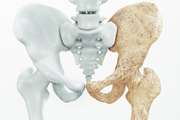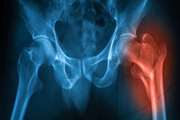چگونه اسیدهای آمینه خون راز پوکی استخوان را فاش میکنند
پوکی استخوان یکی از شایعترین بیماریهای دوران سالمندی است که با کاهش تراکم استخوان و افزایش خطر شکستگی همراه است. شناسایی زودهنگام افراد در معرض خطر، نقشی کلیدی در پیشگیری از عوارض این بیماری دارد.
تأثیر دوره آموزش مجازی پوکی استخوان برای پزشکان عمومی
این مطالعه تأثیر یک برنامه آموزشی مجازی بر مدیریت پوکی استخوان برای پزشکان عمومی را ارزیابی کرد.
Association between serum hemoglobin level and bone mineral density in adults Iranian multi center osteoporosis study (IMOS)
The associations between serum hemoglobin (Hb) levels and bone mineral density (BMD) were investigated in population of the 4th Iranian Multicenter Osteoporosis Study (IMOS). A positive relationship between Hb levels and BMD at hip and femoral neck were detected only in men. Purpose
Evaluation of bone mineral density and its influencing factors in patients infected with HIV under antiretroviral therapy
This study highlights the multifactorial nature of BMD changes in individuals living with HIV. By identifying correlations between metabolic, hormonal, and disease-related factors and bone health, our findings bring attention to an often-overlooked aspect of HIV management, that is patients with HIV may benefit from routine BMD screening, as it could help identify early risks of low BMD.
Identifying determinants for falls among Iranian older adults: insights from the Bushehr Elderly Health Program
Falls are a common cause of fractures in older adults. This study aimed to investigate the factors associated with spontaneous falls among people aged ≥ 60 years in southern Iran.
The association between continuous metabolic syndrome score and its components with electrocardiographic abnormalities in community-dwelling older adults: the Bushehr elderly health (BEH) program
Metabolic syndrome (MetS) known as a risk factor for cardiovascular diseases (CVDs) has developed into a major source of health issue, especially for the elderly. In the present study, we investigated the association between continuous MetS (cMetS) score and its components with electrocardiographic (ECG) abnormalities in the community-dwelling older adults.
Mortality and re-fracture rates in low trauma hip fracture
This study aimed to estimate the incidence rate of re-fracture and all-cause mortality rate in patients with hip fractures caused by minor trauma in the first year following the event.
The process of hip fracture management before and during the COVID-19 pandemic in Iran
The COVID-19 pandemic affected the control of many chronic conditions, including hip fractures, worldwide. This study was to examine the impact of the COVID-19 pandemic on the management of hip fractures in a referral orthopedic hospital in Iran. By understanding how the pandemic has influenced the care of hip fracture patients, we can gain valuable insights into the challenges, adaptations, and potential improvements in orthopedic healthcare during such public health crises.
Association of age-related declined renal function and osteoporosis based on trabecular bone score in Bushehr Elderly Health (BEH) program
Osteoporosis is a systemic disease characterized by decreased bone strength and an increased risk of fracture in old age. Age and pathologic renal failure are independent risk factors for osteoporosis.
Fast-Track Pathway: An Effective Way to Boost Diabetic Foot Care
Diabetes is a chronic disease that challenges global health issues in many aspects. Diabetic foot ulcer (DFU) is one of the most common causes of reduced quality of life and increased hospitalization, amputation, treatment costs, and mortality in patients. Improper patients’ knowledge, unsatisfactory education and training of healthcare workers, and limited facilities are the major cause of delayed referral and downscale management in DFUs.













